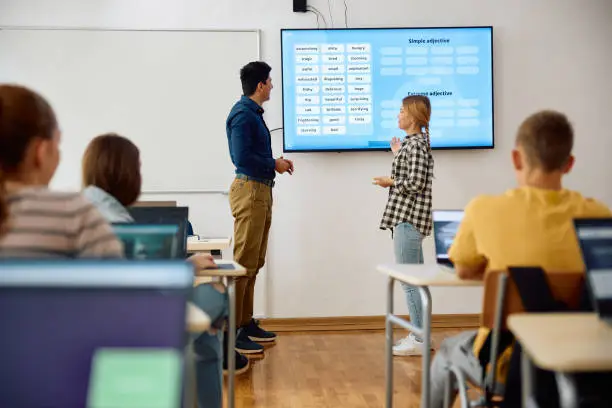The educational landscape is changing, with classrooms worldwide moving beyond traditional chalkboards to embrace interactive technology. Among these advancements, interactive whiteboards have emerged as powerful tools that not only modernize teaching but also transform how students engage with learning. By integrating visuals, touch capabilities, and multimedia options, interactive whiteboards are making lessons more immersive, interactive, and enjoyable. But what exactly makes an interactive whiteboard such an essential tool for today’s classrooms?
Let’s explore how interactive whiteboards are creating an engaging learning experience, sparking curiosity, encouraging collaboration, and fostering a more inclusive environment for students of all ages.
Engaging Visuals That Bring Lessons to Life
In an age where students are surrounded by screens and visuals, capturing their attention in a classroom can be a challenge. Traditional whiteboards or chalkboards may seem static and uninteresting to today’s tech-savvy generation. Interactive whiteboards change the game by offering a vibrant platform that can display high-quality images, videos, and animations, transforming ordinary lessons into visually engaging experiences.
Imagine a history lesson on ancient civilizations. Rather than simply discussing the Great Wall of China, a teacher can show images, videos, or even a virtual tour of the landmark on the interactive whiteboard. This level of immersion not only makes the lesson more exciting but also enhances retention, as students are more likely to remember what they see and interact with.
Promoting Active Participation in the Classroom
Learning is most effective when students are actively involved in the process. An interactive whiteboard allows students to participate directly in lessons, whether by solving math problems, annotating over text, or even leading parts of the lesson. This level of engagement is invaluable, as students are no longer passive listeners; they become active participants in their learning journey.
For instance, in a language arts class, a teacher could display a poem on the interactive whiteboard and invite students to come up and highlight metaphors or similes, discuss the meaning of each line, or even rearrange the structure. This interaction gives students a deeper understanding of the material and a sense of ownership over their learning.
Encouraging Collaboration and Teamwork
One of the greatest benefits of interactive whiteboards is how they foster a collaborative learning environment. In traditional classroom settings, students are often limited to working individually or discussing ideas from their desks. With an interactive whiteboard, however, they can gather around the board, share ideas, and collaborate on projects together.
Consider a science class where students are asked to create a presentation on the water cycle. With the interactive whiteboard, they can collectively add text, images, and even animations to illustrate the process. Each student can contribute their understanding, and the final product reflects their combined efforts. This collaborative experience not only reinforces the material but also teaches essential teamwork skills that students will carry with them long after they leave the classroom.
Simplifying Complex Concepts with Interactive Tools
Some subjects, such as math, physics, and biology, often involve abstract or complex ideas that can be difficult for students to grasp. Interactive whiteboards provide tools that make these concepts more accessible by breaking them down visually and interactively.
For example, in a geometry lesson, a teacher can use the interactive whiteboard to display different shapes, demonstrating how to calculate area and volume. By manipulating these shapes on the screen, students gain a better understanding of the concepts. In a biology class, students could interact with 3D models of cells, examining the structure and function of each part. This hands-on approach allows students to experience the material in new ways, making complex ideas easier to understand.
Catering to Different Learning Styles
Every student learns differently. Some respond well to visual aids, while others may prefer hands-on activities or auditory explanations. Interactive whiteboards offer a flexible platform that caters to all these learning styles, making it easier for teachers to reach every student.
For example, visual learners benefit from images, videos, and diagrams that can be displayed on the interactive whiteboard. Auditory learners can listen to audio explanations, while kinesthetic learners can interact with the board directly. By offering a range of learning methods within a single tool, interactive whiteboards create an inclusive environment that supports all students.
Building Confidence and Engagement
For many students, traditional classroom settings can feel intimidating, especially when it comes to participating or answering questions. The fear of making mistakes in front of peers can be a barrier to learning. However, interactive whiteboards help create a more relaxed, supportive environment where students feel encouraged to share their ideas and engage with the material.
When students are invited to use the interactive whiteboard themselves—whether to solve a problem, present a solution, or share a thought—they gain confidence in their abilities. For example, a shy student might feel hesitant to answer a question verbally, but coming up to the board to interact with a concept physically can make participation less intimidating. This opportunity to shine builds self-esteem and helps students develop a positive attitude toward learning.
Enabling Personalization and Adaptability
Every classroom is unique, and interactive whiteboards allow teachers to tailor lessons to fit the specific needs of their students. Teachers can easily save and revisit previous lessons, track progress, and adapt materials for different learning levels, ensuring no student is left behind.
For example, if a teacher notices that certain students struggle with a topic, they can adjust the lesson, add additional resources, or revisit concepts as needed. This flexibility enables a personalized approach to teaching that meets students where they are, creating a more supportive and responsive learning environment.
Creating an Inclusive and Accessible Classroom
An essential aspect of modern education is creating an inclusive environment where every student feels valued and supported. Interactive whiteboards help make classrooms more accessible to students with diverse needs. For instance, visually impaired students can benefit from enlarged text and graphics, while students with auditory challenges can access captions and visual explanations.
Additionally, the ability to save and share lessons makes it easy for teachers to provide extra resources for students who need more time or missed part of the lesson. These features ensure that every student has an equal opportunity to succeed, regardless of their individual needs.
Preparing Students for a Technology-Driven World
As technology continues to shape our world, it’s essential for students to develop digital literacy skills that will serve them in the future. Interactive whiteboards offer students hands-on experience with digital tools, preparing them for a technology-driven workplace. By becoming familiar with interactive displays, touch interfaces, and digital content, students develop skills that are increasingly relevant in today’s job market.
Furthermore, as students grow comfortable using an interactive whiteboard, they also learn to navigate digital resources, conduct research, and collaborate online—all essential skills for the future. By introducing these tools in the classroom, schools are helping students gain valuable skills that extend beyond academic knowledge.
The Future of Interactive Learning
Interactive whiteboards are more than just a trend; they represent the future of education. As more schools embrace these tools, the classroom experience will continue to evolve, becoming more inclusive, engaging, and responsive to the needs of today’s learners. These boards have set a new standard for what a modern classroom can be: a dynamic environment where students are active participants in their learning journey, supported by technology that makes learning exciting and accessible.
Conclusion: Embracing the Interactive Whiteboard for Enhanced Learning
In conclusion, interactive whiteboards are redefining the classroom experience, creating a space where students and teachers can connect, explore, and learn together. By offering a blend of visual engagement, interactive learning, and adaptability, these boards foster a deeper connection to the material, turning each lesson into an opportunity for discovery and growth. As classrooms continue to adopt interactive whiteboards, the benefits for students and teachers alike will only increase, making education a truly interactive, inclusive, and engaging experience.
By embracing interactive whiteboards, schools are taking a significant step toward the future of education—one where every student has the opportunity to engage, collaborate, and succeed in a learning environment designed for them.

